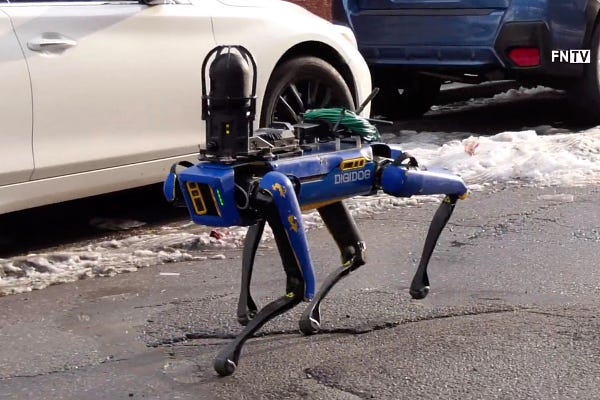Facing the Abyss in Israel/Palestine
A personal note on the crisis and what America needs to do now. Plus, a visionary tech plan for NYC, the state of political tech and much more.
“I believe that one fine day all the children of Abraham
Will lay down their swords forever in Jerusalem.” —Steve Earle, Jerusalem
This is a newsletter about democracy, movements, organizing and technology. I don’t intend to write here often about the Middle East or Israel/Palestine in particular. If you’re here as a subscriber for the former topics, forgive me or just skip to the bottom half of today’s post. But events in that part of the world are weighing heavily on me right now and one purpose of writing is to get things off your chest. So here we go.
I'm an American Jew from a family of Holocaust survivors, some of whom made their way to Israel after WWII and who still live there. A few years ago, my mother donated to the U.S. Holocaust Memorial Museum two unused Star of David badges that were given to her parents in Belgium during the Nazi occupation years. Our trauma does not license Israel's infliction of trauma on the Palestinians.


If you want one thing to read on the chain of events in Jerusalem that led to the explosion in Israel/Palestine now underway, this piece by Haggai Mattar in 972 Magazine does, in my humble opinion, a solid job of explaining how Israel's right-wing government lit the match. That’s both in terms of how it was handling the tensions aroused by the efforts of Jewish settlers to evict longstanding residents of the Sheikh Jarrah neighborhood of East Jerusalem, as well as its handling of Palestinian Muslims gathering in and near the Old City for Ramadan. The Israeli government’s support for the creeping expansion of the Jewish presence in East Jerusalem, along with its longstanding disenfranchisement of the 300,000 Palestinians who live in annexed Jerusalem, has been a destabilizing force in what ultimately should be an internationalized city sacred to three great religions. It’s not for nothing that peace negotiators have always tried to save Jerusalem as one of the last thorny issues to be resolved if Israelis and Palestinians are going to come to terms.
The Biden Administration has also miscalculated in how it has handled America’s role in the conflict. Coming into office, President Biden signaled that he wasn’t interested in trying to restart “the peace process” and that, for understandable reasons, he was going to be more hands-off compared to his predecessors. Unfortunately, I think he failed to recognize how the last four years of Trump encouraging the Israeli right had emboldened the worst elements in Israeli society and politics.
If you think the Proud Boys and the Oath Keepers are a problem in the US, go read up on La Familia, a racist Israeli soccer fan club with several thousand members that worships the Jerusalem-based Beitar team, which is the only team in Israel to have never hired an Israeli-Arab player. La Familia is now suspected to be at the core of many of the anti-Arab riots and vigilante attacks that have broken out in Israel’s cities since the start of this week’s war. (Several thousand in Israel would be like several hundred thousand in the US—estimates on Oath Keeper membership put it around 30,000.) Or read up on how Itamar Ben Gvir, a follower of the late Rabbi Meir Kahane, has not only made his way into Israel’s Parliament but even been welcomed as a potential partner in a governing coalition by its Prime Minister Bibi Netanyahu. Ben Gvir, like Kahane before him, wants Israel to expel its Arab citizens. Other, slightly less feral politicians like Naftali Bennett, who was Netanyahu’s chief of staff and more recently the country’s defense minister, simply refer to the Palestinians as “shrapnel in his butt” that he is willing to live with, but will never allow to have a state of their own.
Biden’s initial comments on the outbreak of war, where he endorsed Israel’s “right to defend itself” against rocket attacks from Hamas but said nothing about the Palestinians, obviously were interpreted as a green light by Netanyahu. Those rocket attacks, which indiscriminately target civilians, are outrageous, but so are Israel's longstanding policies of creeping annexation and anti-Arab discrimination, and now its resort to overwhelming force against the people of Gaza. We are now seeing the bitter fruit of decades of hubris and stupidity, fed by racism and religious fanaticism, and yes, enabled by most American administrations not putting any pressure on Israel to meet its obligations under both American and international law. What's happening now inside pre-1967 Israel--the horrific outbreak of inter-communal violence between angry young Palestinians and angry young rightwing religious Jews--is where all these unchecked trends have been heading. If there’s a silver lining, it’s in the continued efforts to build and sustain Jewish-Arab solidarity there, which this week was evidenced by the many local peace demonstrations organized by Standing Together (Omdim Beyachad).





The basic fact that both sides have to somehow accept is neither is going away. There are roughly 6.8 million Israeli Jews and 6.8 million Palestinian Arabs living between the Mediterranean and the Jordan River and they have to find a way to coexist. Proving every few years that they’re not going away by shooting thousands of rockets or precision-guided weapons at the other side is not a tenable form of coexistence. We Americans, who give nearly $4 billion a year to Israel (and a much smaller fraction to the Palestinian Authority, which was just restored by Biden in April) and who have promised to do so for years to come, should be trying to help them find a better resolution rather than offering one side unquestioning support during this worsening crisis.
Tech and the Next City
On a first fast reading, I’m very impressed by “Rebooting NYC: An Urban Tech Agenda for the Next Administration,” a working draft from the Jacobs Institute at Cornell Tech, written by Rohit T. Aggarwala, Michael E. Bloomberg, Victoria M. Woo, Rebecca Lassman, Adrian Silver, Phillip D. Ellison, Matt Stempeck and Michael M. Samuelian. Hopefully, whomever takes over in City Hall at the end of this year will study this report closely. Here’s a key snippet:
Our work to date has led us to the conclusion that the full use of technology in New York City will be held back unless we tackle several challenges that are political and administrative rather than technological: privacy, administration, and equity. The first of these is that many New Yorkers are hesitant to support the greater use of urban technology because we do not have a comprehensive, credible law governing the use of data collected in the public realm. The second is that the city’s government agencies are right now not fully up to the task of implementing many large-scale technology projects simultaneously; this speaks not to the failures of the many talented individuals in the City, but rather compliments them for getting so much done under the constraints of what we find to be a poor organizational structure and an inability to hire the number of technology experts the City really needs. Finally, New York will never embrace technology fully when it is clear that a large portion of New Yorkers are left out of the digital economy. These three challenges form a prerequisite to the technology-enhanced city.
Those three points lead in very sensible and necessary directions—the passage of an overall privacy and data usage law, the reorganization of how city agencies manage tech (the report pulls no punches in pointing out how the city’s Department of Information Technology and Telecommunications needs to be broken up), the creation of a NYC Digital Services team, the need for much greater civilian oversight and control over how the police use tech and surveillance, and the creation of a Broadband Development Corporation—are all really smart and well-supported proposals in the draft report.
A few weeks ago, New Yorkers reacted viscerally against the cops’ use of a Boston Dynamics robot dog in a housing project in the Bronx, leading to its withdrawal. That episode showed, yet again, that the overly rapid adoption of new tech is fundamentally an authoritarian move. It’s time for slower and more thoughtful, inclusive approaches that start by asking people what they actually need and want, and this draft report does a great job laying out many good ideas worth pursuing.
Odds and Ends
-Speaking of reports worth digging into, I’m looking forward to diving into Higher Ground Labs’ 2020 Political Tech Landscape Report, which came out at the end of April.
-Don’t miss This American Life’s report by David Kestenbaum on how GOP consultant Frank Luntz is trying, with some surprising success, to figure out ways to convince Trump voters to get vaccinated. The quick summary: facts matter, as do illustrative stories, but only when framed in a context those voters can accept and with the right messengers. (The bad news for people like me: bragging about how the mass vaccination program is a giant example of government doing something right will only make it harder to get these voters to do the right thing.)
-Deep thoughts: Cory Doctorow on why he’s been blogging for 20 years is a beautiful reminder of the power of collaborative thinking.
-End times: Margaret Atwood on Laurie Anderson’s 1981 album Big Science and why it’s just as relevant now.





